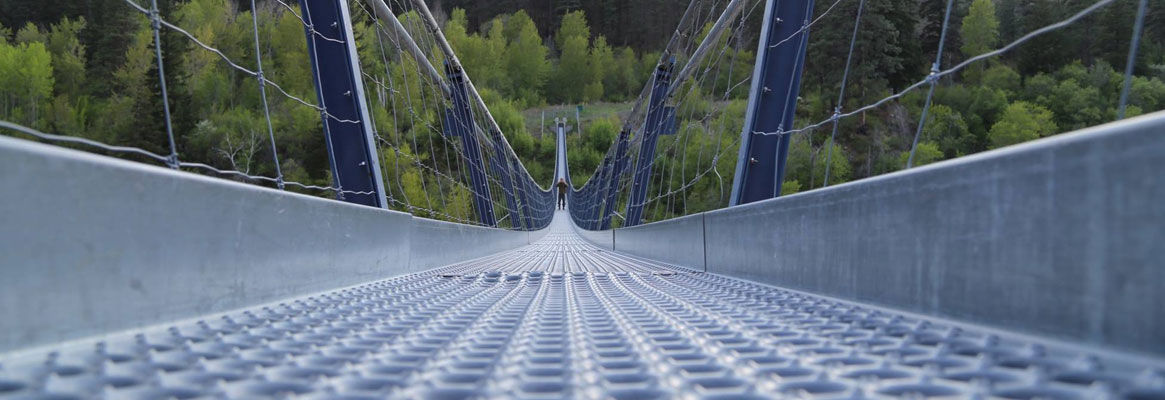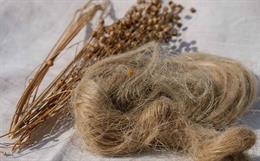Polymers dissolved in volatile solvents can be directed toself-assemble into suspended nanofiber bridges through surface tension drivencapillary thinning. This points towards a single step approach to formingsuspended 3D structures in a considerably more simple way than by standardmicrofabrication processes. Fibers form when the polymer liquid is brushed byhand over a corrugated surface, as shown in the cartoon. To the right of thecartoon is a portion of an array and a closeup of polymer microfibers. Thelarge mounds of polymer, compared to the fiber diameter, show how dramaticallythe fibers have thinned through the capillary forces. Carbon nanotubes can alsobe suspended, by dispersing them in the liquid polymer, forming fibers, and thenthermally decomposing the polymer. The bottom images show the one bridge beforeand after decomposition of the polymer. [2] Bridges under 10 nm wide have beenobserved to form.
The study considers several ways to extend these resultsincluding: improving understanding of the process through rheological modelingand measurements, improving control of the process through automation,employing various polymers for various applications including the synthesis ofnew polymers, and constructing application specific devices based on thesuspended fibers.
In addition to the parallel hand brush-on method, we also have developed an automated point-to-point serial drawing system. [3] The positioning is done with an ultra-precision 3D translation system. Polymer is dispensed through the same capillary tip that is used to pull the fiber. Fibers down to 450 nm diameter have been drawn with this system. The panel on the right shows a fabrication process and capillary for a suspended microfluidic channel that is templated on a suspended fiber drawn by the automated drawing system. The polymer droplets serve to define reservoirs. Gold electrodes are included in the design. Voltages up to 100V have been applied to across the device and fluorescent microbeads have viewed flowing through the capillary under a microscope. [4]
Brush-on is done so fast that the fiber thinning is due entirely to surface tension driven capillary thinning. The serial drawing is generally much slower and both surface tension and viscoelastic effects (due to the fiber solidifying through solvent evaporation during the pulling) causes thinning. The brush-on thinning dynamics were modeled by the McKinley group prior to the start of this study. For the current study we are modeling the combination of viscoelastic and surface tension based thinning, with the goal of determining conditions for obtaining small fibers. The contour plot on the right summarizes our first-pass results of this modeling. It is a map of resulting fiber thinning as a function of processing parameter P (which is larger for faster solvent evaporation rates) and capillary number Ca (which is larger for larger stretching rates). Higher capillary numbers and lower values of P give the most thinning from the initial diameter R0 of the polymer sample. Therefore, with careful control of Ca and P a 1 mm thick polymer sample could be thinned by a factor of 104 or to 100 nm. The model appears to make physical sense, but the simulation has not been specialized for the material parameters and functions (polymer concentration and concentration-dependent viscosity) of the polymer solutions used in our experiments. Once these parameters are determined empirically, the model can be adjusted and the simulation rerun.
The UMass group has focused on the synthesis of biodegradable polymers formed from hydrophobic lactic acid (PLA) and hydroxybutyrate. The lactic acid materials are triblock copolymers containing a central hydrophilic poly(ethylene oxide) segment while the hydroxybutyrate is a homopolymer. We have also prepared and transferred block copolymers based on poly(styrene-methyl methacrylate) and poly(alpha methyl styrene). The block copolymers are excellent materials for forming nanoporous fibers and thin films. The brush-on method was used with 15% solution of the PLLA-PEO-PLLA in chloroform to fabricate fibers with diameters ranging from 125 nm to >50 mm. Then the fibers (see panel) were treated with (a) water, (b) heat and isopropyl alcohol, (c) and (d) heat and water which led to the formation of micrometer and nanometer pores. The images show that the pore structure is quite sensitive to processing conditions. We are considering the use of these fibers as tissue scaffolds for growing microcapillaries from endothelial cells. The field of organ regeneration has yet to demonstrate successful growth of microcapillaries, and without microcapillaries, the limited blood supply makes it impossible to regrow many organs. The PLLA-PEO-PLLA triblock copolymer is both biocompatible and biodegradable, and the ability to tailor the pore sizes and orientation would be useful in investigating issues related to cell growth and the supply of growth factors through the porous material.
Broader impacts
Jessica Fernandes now in her sophomore year in electrical engineering, was a summer REU intern. She contributed to making the porous fibers and is co-author on two submitted conference proceedings. Pictures of the porous fiber have been submitted to the Visual Gallery developed by the UMass MRSEC in support of their development of a K-12 program that integrates science and art, with the goal of attracting more students into science. Four graduate students worked full time and at least 3 other students have contributed to the project results.
References
[1] For further information about this project link to http://www.ee.uofl.edu/~eri or email rwcohn@uofl.edu
[2] S. Pabba, S. M. Berry, M. M. Yazdanpanaah, R. S. Keynton and R. W. Cohn, Nanotube suspension bridges directly fabricated from nanotube-polymer suspensions by manual brushing, 2006 6th IEEE Conference on Nanotechnology (18 July 2006, Cincinnati, OH).
[3] Berry, S. M., Harfenist, S. A., Cohn, R. W., Keynton, R. S. Characterization of Micromanipulator-Controlled Dry Spinning of Micro- and Sub-Microscale Polymer Fibers. J. Micromech. Microeng. 16, 1825-1832 (2006).
[4] At least seven other peer-reviewed conference proceedings and seven abstracts have been accepted or submitted on this project to date.
To read more articles on Textile, Industry, Technical Textile, Dyes & Chemicals, Machinery, Fashion, Apparel, Technology, Retail, Leather, Footwear & Jewellery, Software and General please visit http://articles.fibre2fashion.com
To promote your company, product and services via promotional article, follow
this link: http://www.fibre2fashion.com/services/article-writing-service/content-promotion-services.asp







